

Eat The Weeds & Other Things, Too. A Guide to Wild Greens. For the record, I know nothing about identifying plants in the wild.

Burdock: Pictures, Flowers, Leaves and Identification. Arctium lappa Recognized mainly for its burrs, burdock is an interesting biennial plant because it consists primarily of carbohydrates, volatile oils, plant sterols, tannins, and fatty oils.
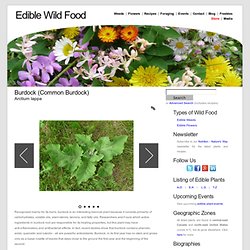
Researchers aren't sure which active ingredients in burdock root are responsible for its healing properties, but this plant may have anti-inflammatory and antibacterial effects. In fact, recent studies show that burdock contains phenolic acids, quercetin and luteolin - all are powerful antioxidants. Dandelion Greens – The Perfect Spring Survival Food. Foraging For Dandelions: Harvesting Tips. Along with the return of robins and whirling bees, I count the appearance of dandelions among the first signs that spring has officially arrived.

I look forward to seeing their cheery butter-yellow flowers, and admire their tenacity as plants. How to Eat Dandelion Flowers. This is a follow-up article to the Dandelion Greens – The Perfect Spring Survival Food article I recently wrote.

If you’ve already tried preparing the dandelion greens from the prior article than you know how delicious this wild plant can be. In this article I wanted to quickly present you with another pair of delicious recipes using a different part of this common every-day plant: the flowers. Pickled Dandelion Flower Buds. Milkweed: A Truly Remarkable Wild Vegetable. Milkweed isn’t your average weed; in fact, I feel guilty calling it a weed at all.

The common milkweed, Asclepias syriacqa, is one of the best known wild plants in North America. Children love to play with the downy fluff in autumn, while farmers despise it as a tenacious weed of hayfields and pastures. Butterfly enthusiasts adore milkweed as the sustenance for their beloved monarch. Hardly any country dweller can fail to notice this unique, elegant plant so laden with fragrant, multi-colored blossoms in midsummer.... Delicious Stinging Nettles Of Spring. Walking near the stream that separates the two 10-acre bottom-land fields of my brother Henry’s vegetable farm, I noticed a bed of dark green nettles about a foot tall — the perfect size for picking.

And although the soft green leaves of the overwintered spinach beckoned just a few steps away, I turned away from the spinach and toward the stream bank and the stinging nettles (Urtica dioica), heeding the irresistible call of the wild. The first wild greens of spring have been highly valued by people around the world who knew they were good food and good medicine too. American Indians gathered nettles to boil and enjoy first thing in the spring when other food plants (including the “three sisters of life”: corn, beans and squash) were still weeks away from being planted, and months away from being harvested. In parts of Nepal and India, stinging nettles (shishnu) are gathered and cooked with Indian spices each spring. Edible Weeds. About Us | Sitemap | Resources All information, blogs and web content contained in this website is Copyright © EdibleWildFood.com 2011.
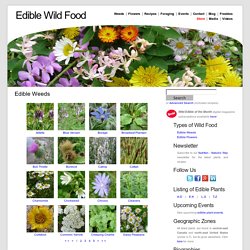
All photography, unless otherwise stated was taken by Karen Stephenson. Free Food in Your Yard: Edible Weeds! Popular in Food & Drink Next time you're about to yank an offending plant from your immaculate garden of perennials, think twice: you just might be looking at dinner.
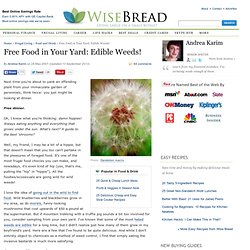
Free dinner. Oh, I know what you're thinking: damn hippies! Always eating anything and everything that grows under the sun. Wild Edibles: Sumac Shoots. Disclaimer: Eating certain wild plants can be deadly!!
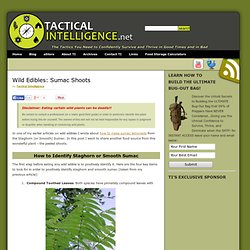
Be certain to consult a professional (or a really good field guide) in order to positively identify this plant before trying this for yourself. Whitetop—A Wild Invasive Substitute for Broccoli. Whitetop is a listed invasive species, targeted for eradication in areas of Colorado and other regions.
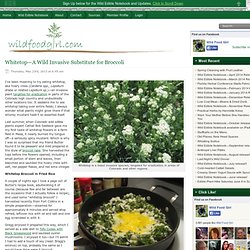
I’ve been meaning to try eating whitetop, aka hoary cress (Cardaria spp., Lepidium draba or related Lepidium sp.) Cold-hearted Cattail Salads. Cattail shoots ready for harvest outside Ithaca, NY, June 2013. After tugging a few from the pond, I went for the easier-to-harvest shoots in a dry area on the pond’s edge. The renowned forager and writer Euell Gibbons called cattails “the supermarket of the swamps,” and from that moniker other nicknames have emerged, among them “the Walmart of the swamps.” Although evoking Walmart doesn’t help me to connect with my joy for wild plants, the sobriquets are so given because of all the different plant food cattails (Typha spp.) yield—from the shoots (aka hearts or leaf cores) and flower spikes* to cattail pollen as flour, along with several underground parts, among which the rhizomes require a bit of processing to separate the edible starches.
It is also often the case that cattails are quite plentiful where they occur, making them a good choice for a sustainable wild harvest. Perhaps easiest to collect and process are the shoots or hearts, also known as “Cossack asparagus.” Wild Edibles: How to Eat Common Milkweed. Disclaimer: Eating certain wild plants can be deadly!! Be certain to consult a professional (or a really good field guide) in order to positively identify this plant before trying this for yourself. How to Eat Japanese Knotweed.